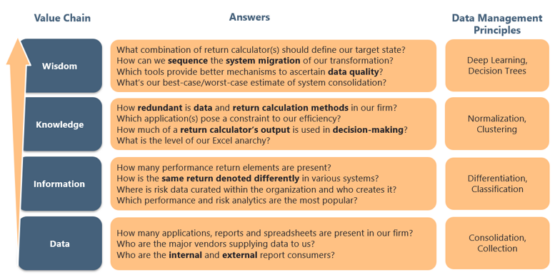“SURROUNDED BY DATA, BUT STARVED FOR INSIGHTS.” – JAY BAER
LEVERAGE CAPABILITIES AVAILABLE IN EMERGING CONVERSION TOOLS TO SUPPORT PLANNING INSIGHTS
In the first paper, we said that Performance is Data, sometimes a daunting data challenge. Performance data generation happens in successive layers. Aggregation of holdings creates exposures; changes in market values or exposures create returns; returns lay the foundation for risk analytics and attribution. If exposures are first order analytics, returns and risk can be considered as second and third order analytics, respectively. One can see successive transformation providing better insights. The same is generally true in the data space.
Our second paper in the ‘Performance is Data’ series explored the facets of utilizing a data-driven approach to operational transformations. It emphasized the importance of creating a comprehensive data inventory during current state assessments¹. As one would expect, a data-driven approach captures a lot of data. Not all of it is valuable, though. Mining data to gain intelligence happens through several stages. Raw data becomes meaningful info with connected relationships. Patterns of information reveal knowledge. Synthesized knowledge is wisdom.
In this paper, we describe the advantages of using a tool to propel data-driven transformations and present a qualified method to reap more value from data collected during transformations with a case study. Finally, we present a case study where Meradia partnered with Zengines to accelerate data analysis. Zengines is a technology software vendor using the latest machine learning techniques and algorithms to fast-track data migrations and conversions.
COLLECTING, ASSIMILATING, CATEGORIZING, AND PROFILING DATA QUICKLY REDUCES TIME-TO-MARKET
The ability to manage torrents of data is critical, but most companies are behind the curve². To capture firm-wide inventory quickly is a tall order. The volume and variety could extend the inventory capture exercise into many months and, in some cases, years.
The importance of a tool is also felt when institutional knowledge is neither organized nor well documented. It reduces reliance on IT teams, which are typically overstretched in most firms. A tool with the following features is essential for a data-driven approach to succeed:
- A robust method to collect data elements from input files (CSV, PDF, etc.), table definitions, database models, and reports.
- Automated mapping and data classification based on pre-defined rules.
- A rich dictionary of financial industry terms with meaningful definitions.
- Flexible user interface to slice and dice inventory on several dimensions such as domain, source, ownership, importance, user(s).
- Insight into the actual data to reveal patterns and trends.
The above points highlight ‘potential significant benefits’, with ‘potential’ being the operative keyword. Expert opinions are extremely valuable but difficult to validate, so how does one differentiate the signal from the noise?
CLASSIFYING AND ASSIGNING RELATIONSHIPS TO UNCOVER PATTERNS CREATES A DATA VALUE CHAIN, EXPOSING HIDDEN VALUE
Data is bits and bytes of sequential arrangement pervading the application landscape of all firms. In isolation, the usefulness of data is limited to non-existent. Yet, it serves as the fundamental building block of understanding and wisdom³. The transition of data from being negligibly useful to substantially meaningful happens as follows:
Data: Data, in its raw form, lacks inherent meaning or usability.
Information: Information is data that has been given meaning by way of relational connection, endowed with relevance and purpose(4). It can be useful but does not have to be.
Knowledge: Knowledge is the appropriate collection of information with the intent to be useful. It involves generating meaningful patterns.
Understanding/Wisdom: The process by which existing knowledge is used to synthesize new knowledge. It can build upon currently held information and knowledge itself. Wisdom is the process of discernment or investigative evaluation.

FIGURE 1: Data Value Chain
Can the above approach (also referred to as systems-thinking)(5) help estimate benefits to transformations? For the purposes of similarity, the approach, when applied to Performance, is shown below.

FIGURE 2: Performance Data Value Chain
A CASE STUDY: USE OF CONVERSION TOOL CALLED ZENGINES TO ACCELERATE DATA INVENTORY WITH RESULTING BENEFITS
Meradia helped a firm managing $200+ billion in assets revamp its decades-old infrastructure. The system landscape was a mix of public and private market investments, including derivatives with multiple books of record and distributed ownership.
Meradia held extensive interviews with accounting, performance, and risk teams to gain insight into the current state. Top-down data flows described how data was moving (strategy-led). Bottom-up field analysis (data-driven) performed with Zengines, an AI-powered platform, explained how data was sourced and used.
Zengines allowed ingestion of 19,000+ data elements from 3 databases, 140 Excel files, and 40 PDFs in a short amount of time, which helped establish a thorough consumption map. Dissected through a system thinking lens, the benefits obtained are shown below.

FIGURE 3: Consumption Map
Although it’s intuitive that answers to questions in higher layers would be useful to executives, there is value in other areas as well. For example, redundancy magnitude could drive business case for performance calculator consolidation; data curation sheds light on areas that require operational controls prior to performance analytics dissemination.
LEVERAGE ADVANCEMENTS IN DATA SCIENCE TO IMPROVE OUTCOMES, A CONCLUSION
Data-driven transformations unearth a lot of information. Proper tools armed with data science techniques accelerate inventory collection and consolidation. There exists a tendency to get lost in the data heap and consider basic metrics (such as diversity of data sources or number of systems) as a proxy for benefit estimation. A framework based on mining intelligence from data asks better questions and yields deeper insights. These insights could be used to plan effective performance architectures – a desirable outcome that increases the benefit side of the ROI equation in the long run.
REFERENCES
¹The paper ‘Operational Transformations: A Data-driven Approach’ described differences between strategy led and data driven transformations and how a comprehensive data inventory can help set the stage for quick wins.
²What’s your Data Strategy? by Leandro DalleMule and Thomas H. Davenport https://hbr.org/2017/05/whats-your-data-strategy, Accessed on 9/16/2023.
³Well-articulated in From Data to Wisdom by Russell Ackoff, Journal of Applies Systems Analysis, Volume 16, 1989 p 3-9.
(4)Quote attributed to Peter Drucker.
(5)Data, Information, Knowledge, and Wisdom by Gene Bellinger, Durval Castro, Anthony Mills, https://www.systems- thinking.org/dikw/dikw.htm#:~:text=Information%3A%20data%20that%20are%20processed,Wisdom%3A%20evaluated%20understanding, Accessed on 9/17/2023.
Download Thought Leadership Article Process Design and Change, Strategy and Roadmap Middle & Back Office Optimization, Performance, Risk & Analytics Industry Vendors, Pension Jose Michaelraj info@meradia.com
info@meradia.com


